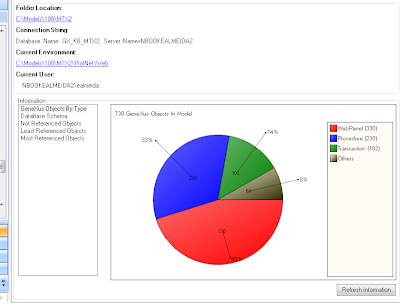Como crear un script que haga inserts de los registros de una tabla (SQL Server)
PROBLEMA: Tengo una tabla con registros y quiero llevar estos registros a otra tabla con el mismo nombre en otra base de datos, en un servidor que no están conectados.
En Creates a data insert script from a table, Nigel Rivett publica un script bueno para crear las sentencias insert, con los valores de tablas que ya existen. Es bueno para pasar los registros que me funcionan correctamente en el ambiente de desarrollo a produccion, a traves de un script.
Copio el script para crear el stored procedure, que luego puede usarse para crear el script. Me resultó muy util.
Tiene un problema con el formato de las fechas, pero es facilmente solucionable.
En Creates a data insert script from a table, Nigel Rivett publica un script bueno para crear las sentencias insert, con los valores de tablas que ya existen. Es bueno para pasar los registros que me funcionan correctamente en el ambiente de desarrollo a produccion, a traves de un script.
Copio el script para crear el stored procedure, que luego puede usarse para crear el script. Me resultó muy util.
Tiene un problema con el formato de las fechas, pero es facilmente solucionable.
if exists (select * from sysobjects where id = object_id(N'[dbo].[sp_CreateDataLoadScript]') and OBJECTPROPERTY(id, N'IsProcedure') = 1)
drop procedure [dbo].[sp_CreateDataLoadScript]
GO
Create Procedure sp_CreateDataLoadScript
@TblName varchar(128)
as
/*
exec sp_CreateDataLoadScript 'MyTable'
*/
create table #a (id int identity (1,1), ColType int, ColName varchar(128))
insert #a (ColType, ColName)
select case when DATA_TYPE like '%char%' then 1 else 0 end ,
COLUMN_NAME
from information_schema.columns
where TABLE_NAME = @TblName
order by ORDINAL_POSITION
if not exists (select * from #a)
begin
raiserror('No columns found for table %s', 16,-1, @TblName)
return
end
declare @id int ,
@maxid int ,
@cmd1 varchar(7000) ,
@cmd2 varchar(7000)
select @id = 0 ,
@maxid = max(id)
from #a
select @cmd1 = 'select '' insert ' + @TblName + ' ( '
select @cmd2 = ' + '' select '' + '
while @id < @maxid begin select @id = min(id) from #a where id > @id
select @cmd1 = @cmd1 + ColName + ','
from #a
where id = @id
select @cmd2 = @cmd2
+ ' case when ' + ColName + ' is null '
+ ' then ''null'' '
+ ' else '
+ case when ColType = 1 then ''''''''' + ' + ColName + ' + ''''''''' else 'convert(varchar(20),' + ColName + ')' end
+ ' end + '','' + '
from #a
where id = @id
end
select @cmd1 = left(@cmd1,len(@cmd1)-1) + ' ) '' '
select @cmd2 = left(@cmd2,len(@cmd2)-8) + ' from ' + @tblName
select '/*' + @cmd1 + @cmd2 + '*/'
exec (@cmd1 + @cmd2)
drop table #a
go



LE HICE ALGUNOS CABIOS PAR LAS FECHAS Y SOPORTAR TABLAS CON MAS COLUMNAS, ASI COMO GENERAR PARA VARIAS AL TIEMPO
ResponderBorrarALTER Procedure [dbo].[sp_CreateDataLoadScript]
@TblName varchar(128)
as
create table #a (id int identity (1,1), ColType int, ColName varchar(128))
insert #a (ColType, ColName)
select case when DATA_TYPE like '%char%' then 1 when DATA_TYPE like '%date%' then 2 else 0 end ,
COLUMN_NAME
from information_schema.columns
where TABLE_NAME = @TblName
order by ORDINAL_POSITION
if not exists (select * from #a)
begin
raiserror('No columns found for table %s', 16,-1, @TblName)
return
end
declare @id int ,
@maxid int ,
@cmd1 varchar(8000) ,
@cmd2 varchar(8000), @cmd2Prima varchar(8000)
set @cmd2Prima = ' '
select @id = 0 ,
@maxid = max(id)
from #a
select @cmd1 = 'select 1, '' insert ' + @TblName + ' ( '
select @cmd2 = ' + '' select '' + '
while @id < @maxid begin
select @id = min(id) from #a where id > @id
select @cmd1 = @cmd1 + ColName + ','
from #a
where id = @id
select @cmd2 = @cmd2
+ ' case when ' + ColName + ' is null '
+ ' then ''null'' '
+ ' else '
+ case when ColType = 1 then ''''''''' + ' + ColName + ' + '''''''''
when ColType = 2 then ''''''''' + convert(varchar(10),' + ColName + ', 103) + '''''''''
else 'convert(varchar(20),' + ColName + ')' end
+ ' end + '','' + '
from #a
where id = @id
if len(@cmd2) > 7000
begin
set @cmd2Prima = @cmd2
set @cmd2 = ' '
end
end
--averiguar si hay columna identity
declare @cur cursor , @ColName varchar(128)
SET @cur = CURSOR SCROLL KEYSET FOR select ColName from #a
OPEN @cur
FETCH NEXT FROM @cur into @ColName
declare @ident bit
set @ident = 0
while @@fetCh_status = 0 and @ident = 0
BEGIN
if (SELECT COLUMNPROPERTY( OBJECT_ID(@tblName),@ColName,'IsIdentity')) = 1
set @ident = 1
FETCH NEXT FROM @cur into @ColName
end
close @cur
deallocate @cur
select @cmd1 = left(@cmd1,len(@cmd1)-1) + ' ) '' '
select @cmd2 = left(@cmd2,len(@cmd2)-8) + ' from ' + @tblName
declare @cmd3 varchar(500), @cmd4 varchar(100)
if @ident = 1
begin
set @cmd3 = 'select -1, '' set identity_insert ' + @tblName + ' on '' union '
set @cmd4 = ' union select 9999999, '' set identity_insert ' + @tblName + ' off '' '
end
else
begin
set @cmd3 = ' '
set @cmd4 = ' '
end
set @cmd3 = @cmd3 + 'select -2, '' set dateformat dmy '''
set @cmd3 = @cmd3 + ' union '
--select '/*' + @cmd3 + @cmd1 + @cmd2Prima + @cmd2 + @cmd4 + '*/'
exec (@cmd3 + @cmd1 + @cmd2Prima + @cmd2 + @cmd4)
drop table #a
GO
/****** Objeto: StoredProcedure [dbo].[sp_CreateDataLoadAllTables] Fecha de la secuencia de comandos: 04/22/2008 17:54:36 ******/
SET ANSI_NULLS ON
GO
SET QUOTED_IDENTIFIER ON
GO
ALTER proc [dbo].[sp_CreateDataLoadAllTables] @fitro varchar(100)
as
--exec sp_CreateDataLoadAllTables '%Empleado%'
declare @cur cursor , @ColName varchar(128)
SET @cur = CURSOR SCROLL KEYSET FOR select Table_name from information_schema.tables
where Table_name like @fitro
order by Table_name
OPEN @cur
FETCH NEXT FROM @cur into @ColName
while @@fetCh_status = 0
BEGIN
exec sp_CreateDataLoadScript @ColName
FETCH NEXT FROM @cur into @ColName
end
close @cur
deallocate @cur
VISITA WWW.CEROESTRES.COM
Boris:
ResponderBorrarVoy a probar los cambios que propones y despues te cuento.
Gracias!
Enrique
Gracias Enrique por tus aportaciones.
ResponderBorrarComo sabes, no hay casi nada en la red sobre como subir y bajar IMAGENES a BBDD Mysql con PHP, quizás tambien Dreanweaaver.
¿PODRIAS HACERNOS UN EXTENSO, A LA VEZ QUE COMPRESNSIBLE, SCRIPT SOBRE COMO MANEJAR FOTOS ENN BBDD?
gRACIS ANTICIPADAS
Anonimo:
ResponderBorrarEn
http://php.about.com/od/phpwithmysql/ss/Upload_file_sql.htm
podes encontrar un ejemplo detallado de como hacer lo que queres.
Enrique
No funciona cuando hay campos de tipo Image... Alguien podria ayudar a que funcione cuando la tabla tiene campos image...
ResponderBorrar